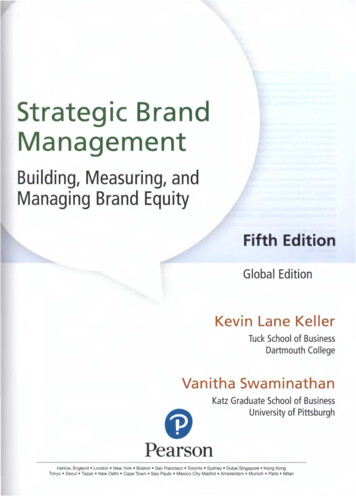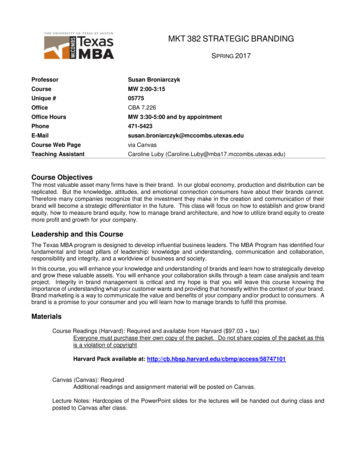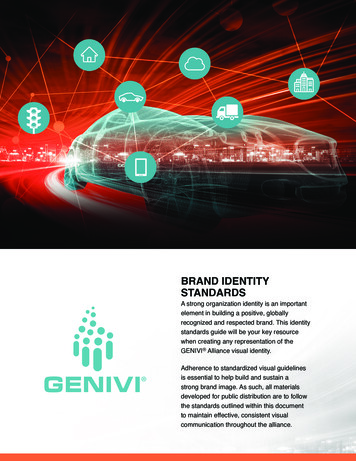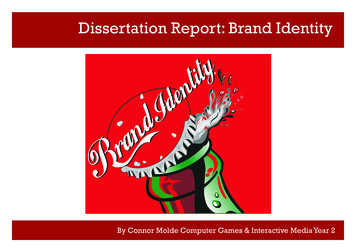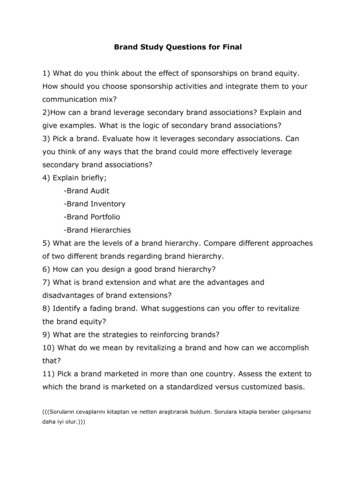
Transcription
Independent Journal of Management &ProductionE-ISSN: 2236-269Xijmp@ijmp.jor.brInstituto Federal de Educação, Ciência eTecnologia de São PauloBrasilde Paula e Silva Chaves, EduardoIDENTITY, POSITIONING, BRAND IMAGE AND BRAND EQUITY COMPARISON: AVISION ABOUT QUALITY IN BRAND MANAGEMENT.Independent Journal of Management & Production, vol. 8, núm. 4, octubre, 2017, pp.1246-1263Instituto Federal de Educação, Ciência e Tecnologia de São PauloAvaré, BrasilAvailable in: http://www.redalyc.org/articulo.oa?id 449553639006How to citeComplete issueMore information about this articleJournal's homepage in redalyc.orgScientific Information SystemNetwork of Scientific Journals from Latin America, the Caribbean, Spain and PortugalNon-profit academic project, developed under the open access initiative
INDEPENDENT JOURNAL OF MANAGEMENT & PRODUCTION (IJM&P)http://www.ijmp.jor.brv. 8, n. 4, October - December 2017ISSN: 2236-269XDOI: 10.14807/ijmp.v8i4.637IDENTITY, POSITIONING, BRAND IMAGE AND BRAND EQUITYCOMPARISON: A VISION ABOUT QUALITY IN BRANDMANAGEMENT.Eduardo de Paula e Silva ChavesSão Paulo Federal Institute, São Paulo University, BrazilE-mail: eduardochaves@ifsp.edu.brSubmission: 20/02/2017Revision: 01/03/2017Accept: erstandingoftherelationships between market and consumption, as well as theconcepts related to the maximization of a company’s results. Thisarticle sought to understand the relationships between brand identity,positioning, brand image and brand equity. We conducted aqualitative-quantitative research to describe the existing connectionsbetween these definitions, and the conceptual and operational gapsthat arise from their management. The results present someanalyses of these gaps.Keywords: Brand identity, positioning, brand image and brandequity.Track: Product and brand /3.0/us/]Licensed under a Creative Commons Attribution 3.0 United States License1246
INDEPENDENT JOURNAL OF MANAGEMENT & PRODUCTION (IJM&P)http://www.ijmp.jor.brISSN: 2236-269Xv. 8, n. 4, October - December 2017DOI: 10.14807/ijmp.v8i4.3251. INTRODUCTIONAccording to Kotler and Keller (2006, p. 337), the bargaining power of buyersgrows as they focus on some issues: when the product represents a significantportion of the buyer’s cost; when the product is undifferentiated; when the costs ofswitching vendors are low; when buyers are price sensitive due to low profit margins;or when previous stages can integrate the supply chain. For Isoraite (2016), severalvariables are growing and gaining importance with digital tools. Thus, it is necessaryto study the relationship between marketing variables.Kotler (2011) states that "to have low prices is not enough to build a feasiblebusiness, you need to add quality and services for the customer to feel that he isbuying based on value”.Thus, it is not sufficient just to do marketing activities, it is necessary toinvestigate if the market uses and appreciates these actions, so that they can bringresults, because it is increasingly difficult to keep loyalty strategies in the retailsector.A high level of consumer’s loyalty is based on the performance perceivedthrough his complete satisfaction. Customers’ satisfaction becomes a leading retailmarketing goal (KOTLER; KELLER, 2006, p. 165).Loyalty is a big competitive differential, because loyal customers givepreference to a brand, are less sensitive to price and pay less attention tocompetitors (AAKER, 1998).Therefore, we defined the following research question: What are the mainvariables that affect the quality of brand management? To do this, we studied themain concepts related to brand management, such as identity, positioning, brandimage and brand equity, through the tools used in the retail market to assess theloyalty of consumers. In parallel, we sought to identify which of these tools areefficient and effective for brand management, and how to improve their 0/us/]Licensed under a Creative Commons Attribution 3.0 United States License1247
INDEPENDENT JOURNAL OF MANAGEMENT & PRODUCTION (IJM&P)http://www.ijmp.jor.brISSN: 2236-269Xv. 8, n. 4, October - December 2017DOI: 10.14807/ijmp.v8i4.3252. THEORETICALIn this section we address the following topics: brands, marketing mix, identity,positioning, image and brand equity, according to the texts and authors found in theliterature research.2.1.BrandAccording to Aaker (1998, p. 7) "a brand is a distinct name and/or a symbolthat aims to identify a seller’s goods or services and differentiate these goods andservices from its competitors”. But for Tomiya (2010, p. 26), logo, name, packing,communication and design are consequences of a branding strategy in theorganizational culture, in the objectives, in the articulation of positioning and in thebrand’s differential. The challenge of brand definition is to develop a deep set ofmeanings for it. If the company treats a brand just as a name, it fails in not giving itimportance (KOTLER; 2011, p. 394).The process of brand management is used to develop awareness and extendcustomer’s loyalty (WHEELER, 2012, p. 16). Corrêa (2009, p. 310) states thatbuilding a brand in the consumer's mind goes through three stages: the creation of aunique concept that differentiates the brand from competitors (differentiation), thereason transmitted by the brand for the consumer to prefer it (relevance), theemotional relationship between the brand and the consumer (esteem).Brands have three main functions: navigation, which helps consumers tochoose the brand among various options; security, through brand communication onthe quality of the product or service, thus passing safety to the customer in hisdecision making; and the engagement that brands provide through images andlanguages, in order to lead the customer to identify with the brand (WHEELER,2012, p. 12).2.2.Brand IdentityWheeler (2012, p. 58) states that brand identity is a strategic tool and an assetthat provides quality reporting, increased recognition and competitive differences.For Kotler (2011, p. 262) identity comprises the forms adopted by a company toidentify itself or to position its 0/us/]Licensed under a Creative Commons Attribution 3.0 United States License1248
INDEPENDENT JOURNAL OF MANAGEMENT & PRODUCTION (IJM&P)http://www.ijmp.jor.brISSN: 2236-269Xv. 8, n. 4, October - December 2017DOI: 10.14807/ijmp.v8i4.325A strong brand should have a clear and valuable identity; if it doesn’t, this mayimply that the brand needs to be changed or extended. Identity represents what theorganization wants its brand to mean (AAKER; JOACHIMSTHALER, 2000, p. 49).To combine the two large brand dimensions (external audience - tangible, andinternal audience - intangible), it is necessary to develop a prism. These dimensionsmust be described for each brand, in order to make clear the brand identity and themain external perceptions regarding it (TOMIYA, 2010, p. 52).For Wheeler (2012, p. 21) brand identity helps to differentiate it from thecompetitors, in building awareness and strengths of an organization, in buildingbrand value, through increased awareness, recognition and loyalty from customers,which contributes –to the firm’s success. To be effective, brand identity should focuson clients, differentiate the brand from competitors and represent what theorganization can do over time (AAKER; JOACHIMSTHALER, 2000, p. 50).2.3.Brand PositioningPositioning was developed by Al Ries and Jack Trout in 1981, who defined itas the basis for enterprises to build their brands and customer relationships.Positioning addresses the mix of price, product, promotion/advertising and place,called the marketing mix g. Through these strategies, companies determine theirposition in the consumer's mind, considering its competitors, and analyzing theirstrengths and weaknesses (WHEELER, 2012, p. 24).According to Aaker and Joachimsthaler (2000, p. 51), brand positioning is partof the brand identity and value proposition that will be actively transmitted to thetarget audience. Positioning is what the brand wants to be for its consumers(CORRÊA, 2009, p. 313).For Tomiya (2010, p. 60) brand positioning should start from its identity. Thepositioning proposal has to be different, unique and communicated to the –targetaudience, clearly showing the advantages of the brand in relation to its keycompetitors.Positioning must present a description of the consumers and what they wantagainst the competitive advantages of the company, besides being a reference forcustomers to use or buy the brand (TYBOUT; STERNTHAL, in TOMIYA, 2010, us/]Licensed under a Creative Commons Attribution 3.0 United States License1249
INDEPENDENT JOURNAL OF MANAGEMENT & PRODUCTION (IJM&P)http://www.ijmp.jor.brISSN: 2236-269Xv. 8, n. 4, October - December 2017DOI: 10.14807/ijmp.v8i4.3252.4.Brand ImageAccording to Cooper (2003), a concept is a set of generally acceptedmeanings and characteristics associated with certain facts, objects, conditions,situations and behaviors. Concepts are frequent and of general use, having beendeveloped over time through shared use. Yet a construct is an image or ideainvented specifically for a particular research and/or for developing theory.Constructs combine the simplest concepts, especially when the idea or image thatwe want to build is not directly subject to observation.Brand image is defined as the perception of the brand reflected in theconsumer memory associations (KELLER, 1993).2.5.Brand EquitySrivastava and Shocker (1991) define brand equity, based on the client, as aset of associations and behaviors of customers, distributors and the parent companyof a brand, which allows for higher sales volume and higher margins than would bepossible without the brand name, in addition to a stronger competitive advantageand differential.To understand brand knowledge and how it relates to brand equity, based onthe client, we need to understand the basic notions of the memories principles.Brand equity, based on the client, is defined as different effects, brand awarenessacts, on the consumer response to the marketing mix, or to the marketing activitiesof the company (KELLER, 1993).In defining brand equity based on the client, attributed to memory, we mustreflect on its mediating position between the action of marketing and profits, and alsounderstand its character of cognitive reservoir. That is, a set of associations andbehaviors of customers and distributors of a brand that allow a distributor to gethigher sales and margins than would be possible without the brand s/by/3.0/us/]Licensed under a Creative Commons Attribution 3.0 United States License1250
INDEPENDENT JOURNAL OF MANAGEMENT & PRODUCTION (IJM&P)http://www.ijmp.jor.brISSN: 2236-269Xv. 8, n. 4, October - December 2017DOI: 10.14807/ijmp.v8i4.3253. METHODOLOGY AND PREMILIMINARY ANALYSIS3.1.Research typeThe article was built through an exploratory-descriptive study. Malhotra (2004,p. 100) states that exploratory research is significant in situations where theresearcher does not have the necessary knowledge to continue the research project.For Hair, Babin, Money and Samouel (2005, p. 86), descriptive research is used tomeasure the characteristics addressed in a research question. Thus we obtained aqualitative result with the case study and a quantitative result with the descriptiveresearch.The methodology and database follow the work of Rodrigues, Menegazzo andChaves (2014), whose contribution was unprecedented regarding the relationsbetween identity, positioning, image and brand equity, mentioned in the next items.This contribution refers to the phenomenological method, and the concepts acquiredby the present author after many years of work with brands, both academic andcommercial.3.2.MethodsThe method used in this work consists of three parts: first, a case study withsupermarket managers; second, a field survey using questionnaires; third, an indepth and phenomenological analysis of the relationships between identity,positioning, image and brand equity. This article developed a qualitative case studytogether with a quantitative descriptive research in order to study the retail tools usedto get customers’ loyalty, and to analyze if these tools are being efficient andeffective (HAIR et al., 2005). To achieve the objectives, we conducted a comparativeanalysis of the case study (indoors) and the descriptive research (externalenvironment). That is, there was a qualitative-quantitative and phenomenologicalbasis for the paper. In this section we discuss the results of the in-depth interviewwith the supermarket managers and the data analysis resulting from the descriptivesurvey of consumers. Initially we present the diagnosis on the vision of thesupermarket retail brand (RODRIGUES et al., 2014).3.3.Case Study"When one of the goals is to achieve qualitative assessments in order to buildtheories, case study research is indicated" (MARTINS; THEÓPHILO, 2009, p. /]Licensed under a Creative Commons Attribution 3.0 United States License1251
INDEPENDENT JOURNAL OF MANAGEMENT & PRODUCTION (IJM&P)http://www.ijmp.jor.brISSN: 2236-269Xv. 8, n. 4, October - December 2017DOI: 10.14807/ijmp.v8i4.325We conducted this research by studying the brand, in which the strategies referringto price, product, place and promotion were analyzed, in order to outline thestrategies and competitive advantages used to gain and keep customers’ loyalty.These variables were chosen because when the 4 P's are related to the company(internal), they are directly based on the 4 C's of consumer (external), which makesthis tool efficient and effective, achieving consumer’s satisfaction without overlyincreasing internal costs (KOTLER; ARMSTRONG, 2007). The achieved resultprovided the analysis of brand positioning before its consumers.When seeking different ways to investigate one point, seeks to triangulation.This triangulation is used to maximize the credibility of the qualitative study,) statedthat triangulation is a procedure that stands out to maximize credibility.Was held with the manager marks an in-depth interview, this type of interviewallows dealing with complex issues that could hardly be properly investigatedthrough questionnaires, exploring them in depth. Then he drew up a roadmap withonly a few questions to guide the interview. (Writing Qualitative ANNEX B). AlvesMazzotti and Gewandsznajder (2001, p.169) consider documents "any written recordthat can be used as a source of information." The document analysis will be used tocheck and complete the data obtained by other techniques.). We conductedunstructured observation in four stores of the brand, to confirm the data collected, asunstructured observations are free, without a way to preset registration). Contentanalysis raised was based on the idea by Alves–Mazzotti and Gewandsznajder(2001) who claim that the content needs to be organized and understood through anongoing process to identify relationships and dimensions, with the goal of uncoveringmeanings.3.3.1. Case Study AnalysisIn these interviews we did not find indications of the use of the marketing mixas a positioning tool. The manager uses the brand with great importance, the toolsproposed by Kotler and Armstrong together with constant research of the market.According to the manager of brand loyalty, conquest is by conductingsatisfaction survey, where the employee himself is trained to listen to customercomplaints; search door to door; customer service, which measures the satisfactionof the purchase accomplished through the aftermarket. For the manager of the s/]Licensed under a Creative Commons Attribution 3.0 United States License1252
INDEPENDENT JOURNAL OF MANAGEMENT & PRODUCTION (IJM&P)http://www.ijmp.jor.brISSN: 2236-269Xv. 8, n. 4, October - December 2017DOI: 10.14807/ijmp.v8i4.325"loyalty keeps us credible. You lose the customer from the moment he losesconfidence in the location he frequents. Cleanliness, validity, quality, variety, serviceare small aspects of trust. No customer retention without trust".The retail brand has four units located in four main regions (RODRIGUES, etal., 2014).For Brand, promotion is one of the most important aspects, the managerstating that invests "close to 1% of sales, more than 100 thousand month ofadvertising, is a major cost today". Some of the tools used by retailers brand istabloid, radio, TV, social campaigns, promotion of products according to seasonality,outdoor, city events, internet. "We are who makes more marketing" (RODRIGUES;MENEGAZZO; CHAVES, 2014).The manager of brand claims that "price is credibility, trust, and the fight tohave uniformity, not to have large bumps market". The retail sector separates twoclasses of products as priced: perishables and groceries, the price of groceries is thesame in any supermarket. For the Brand "price is perishable trust, price is notgroceries. The concept of price is the customer's mind. Since price is value added, isthe brand's status, yet . "Relating price and the supplier have the following brandpositioning: when all the lower price and not have to take more margin comes intocontact with the supplier to take advantage” (RODRIGUES; MENEGAZZO;CHAVES, 2014).The brand performs extensive work in the aftermarket, where checks - withcustomers "is missing some product in your shopping allowed to buy any brandeditem, and why not buy this product", from the responses register the missing productand the information is passed along to the Manager, aiming to leave not miss theitems mentioned. There are also a major concern with products manufactured withinthe establishment, especially with regard to quality and hygiene, using the sametools mentioned (RODRIGUES; MENEGAZZO; CHAVES, 2014).3.4.Descriptive ResearchWe conducted the survey through questionnaires based on the variables ofthe 4P's of the marketing mix that can influence loyalty: price, product, place,promotion, and three questions related to the level of loyalty for the brand, having toverify whether the tools used by the brand are being efficient and effective in ]Licensed under a Creative Commons Attribution 3.0 United States License1253
INDEPENDENT JOURNAL OF MANAGEMENT & PRODUCTION (IJM&P)http://www.ijmp.jor.brISSN: 2236-269Xv. 8, n. 4, October - December 2017DOI: 10.14807/ijmp.v8i4.325process of loyalty. The result of the descriptive survey revealed the image of thebrand in the importance of the variables that influence loyalty.One objective of descriptive research is to obtain a quantitative result thusapplied the questionnaire because they "are used to collect quantitative data from alarge number of people in a quick and convenient way". (HAIR et al., 2005, p 157).For the validation of the factor analysis that allows synthesizing the volume ofinformation collected on variables in a significantly smaller number of variables andfactors. (HAIR e. al., 2005). The reliability analysis is needed to estimate what is thereliability of the measurements and average statistics made on the sample.(Quantitative Questionnaire Appendix B). These data were tabulated in Excel andstatistically analyzed with the aid of the software Statistic Package for Social Science(SPSS), enabling the application of quantitative analysis.Rey (1993), states that the concept of regression in statistics is related topositive or negative that the dependent variable suffers when there is a one-unitincrease in the independent variable. We used the Multiple Regression, whichaccording to Hair et al. (2005) is the most realistic. Loyalty was used as thedependent variable, and the marketing mix as independent variables in multipleregression, it is possible to insert independent variables of the same type in theequation and estimate a single dependent variable. ).Was analyzed by regression analysis of randomness that comes from two ormore variables, or external factors that may influence the concealment of somefunctional relationships. (REY, 1993); multicollinearity by analysis that provides moreaccurate estimators of regression coefficients. (WERKEMA; AGUIAR, 1996); throughthe analysis of normality, which involves the verification of hypotheses anddevelopment of confidence intervals and also heteroscedasticity which analyzes thelevel of discrepancy between the independent variables. (BUSSAB, 1998). placeGujaratiAlpha Conbrach's are measures of reliability. These range from 0 to 1. Thecloser to 1, the degree of reliability is attributed. Being 0.60 and 0.70 limits foracceptable values, ie, they are the minimum acceptable for a variable to be belowthose numbers they are not acceptable to the Alpha's Conbrach (HAIR et al., 2005,p. /]Licensed under a Creative Commons Attribution 3.0 United States License1254
INDEPENDENT JOURNAL OF MANAGEMENT & PRODUCTION (IJM&P)http://www.ijmp.jor.brISSN: 2236-269Xv. 8, n. 4, October - December 2017DOI: 10.14807/ijmp.v8i4.325Factor for Hair et al. (2005, p. 90) consists of a linear combination of theoriginal variables, namely the case of pools variable factor in explaining or summingthe set of 'n' variables in a single factor "x".Correlation to assess whether there is a relationship between the behavior oftwo or more variables and the extent to which this interaction occurs. A positivecorrelation (0 r 1) indicates that the two variables tend to increase or decreasesimultaneously. A negative correlation coefficient (-1 r 0) when said variable valuetends to increase the other tends to decrease, and vice versa. The value "1" or "-1"indicates a perfect linear relationship. The value "0" indicates no linear relationshipbetween the variables. (HAIR et.al, 2005, method 313).3.4.1. Descriptive Research AnalysisFor the analysis of the variables the type of Likert scale was used, accordingto Bell (2008) cited in Machado, Camfield, Cipolat and Quadros (2012, p. 7) thesescales are used to unlock the power of feeling or attitudes towards the subject of thequestions. The questionnaire was applied at the outlet of the brand stores, aiming togive up the post-consumption data, because when interviews are held in the outputof an establishment, people are chosen bearing in mind the fact that just to use theproperty.3.4.1.1.ReliabilityFirst we analyzed the degree of confidence of individual variables. Where wegot the results shown above. The form of analysis was based on the idea of Hairet.al (2005) on the size of the Cronbach's alpha coefficient, as already mentioned inthe figure. Rated up to LE1, LE2, LE3 (loyalty variable) issues as very good, where itcan be concluded that the combined of LE1, LE2 and LE3 measure loyalty issuescoherently.The questions, NL1, NL2, NL3 (variable level of loyalty) are classified asgood, with this result we obtain a set of questions that measure levels Loyaltyconsistently. P01, PO2, PO3 (variable products) make up a group that issues can beclassified as moderate, this result can also conclude that PO1, PO2, PO3 measureproduct consistently.Have questions formed by PA1, PA2, PA3 (group variable place), PAO1,PAO2, PAO3 (group promoting variable), PE1, PE2, PE3 (group variable us/]Licensed under a Creative Commons Attribution 3.0 United States License1255
INDEPENDENT JOURNAL OF MANAGEMENT & PRODUCTION (IJM&P)http://www.ijmp.jor.brISSN: 2236-269Xv. 8, n. 4, October - December 2017DOI: 10.14807/ijmp.v8i4.325classified as low intensity of association, and up as a result groups that do notconsistently measure the variables place, promotion and price.Figure 1: Cronbach's Alpha ResultsSource: Rodrigues, Menegazzo, Chaves; 2014.3.4.1.2.Preliminaries RegressionWe conducted a pre-test in Excel with fifteen questionnaires to conduct ananalysis of collection time, understanding of the issues, quantity demand andconsistency issues for better collection.3.4.1.3.Regression Variables PureAfter the tab in the Excel program, held an average with issues of fairnessvariable (LE) over issues of fairness level (NL), in order to obtain only one dependentvariable named LE (overal). In the following was carried out with a regression LEdependent variable and PAO1, PaO2 PAO3, PE1, PE2, PE3, PE4, PO1, PO2, PO3,PA1, PA2, PA3, independent variables, yielding the following equation:LE(OVERAL) PAO1 PAO2 PAO3 PE1 PE2 PE3 PE4 PO1 PO PO3 PA1 PA2 PA3 Figure 2: Variables Equation PureSource: Rodrigues, Menegazzo, Chaves; 2014.Based on this result it was found that these variables influence the fairness in42.6. But this value is a relationship that is mild to social science. It found the need toperform a correlation of these pure variables, obtaining the result of the individualinfluence of each variable to the loyalty, where he managed the variable thatexplains the most and the least variable that explains the fairness, performing ]Licensed under a Creative Commons Attribution 3.0 United States License1256
INDEPENDENT JOURNAL OF MANAGEMENT & PRODUCTION (IJM&P)http://www.ijmp.jor.brISSN: 2236-269Xv. 8, n. 4, October - December 2017DOI: 10.14807/ijmp.v8i4.325analysis of the pure variables, ie, LE1, LE2, LE3, PE1, PE2, PE3, PE4, PA1, PA2,PA3, PO1, PO2, PO3, PAO1, PAO2, PAO3, NL1, NL2, NL3.3.4.1.4.Complete Regression fairness factor.In search of a better explanation for the research problem we used theanalysis tool dimension reduction SPSS software to transform variables on factors,transforming LE1, LE2, LE3, NL1, NL2, NL3 issues only loyalty factor. To obtain amore accurate result than the average performed in Excel. Thus originated thefollowing regression equation:LE PAO1 PAO2 PAO3 PE1 PE2 PE3 PE4 PO1 PO PO3 PA1 PA2 PA3 Figure 3: Outcome 2: Loyalty FactorSource: Rodrigues, Menegazzo, Chaves; 2014.Figure 4: Loyalty Factor EquationSource: Rodrigues, Menegazzo, Chaves; 2014.Transforming LE1, LE2, LE3, NL1, NL2, NL3 issues only one factor can obtain aresult that represents a significant intensity relative to the social science regressionanalysis.Loyalty Price Product Promotion Place Figure 5: Factors EquationSource: Rodrigues, Menegazzo, Chaves; 2014.Based on this improvement in results, we used factor in all the independentvariables, transforming PAO1, PAO2, PAO3 factor in Deal; PE1, PE2, PE3, PE4factor in price; PO1, PO, PO3 in product and factor PA1, PA2, PA3 in place factor.Thus originated the following regression .0/us/]Licensed under a Creative Commons Attribution 3.0 United States License1257
INDEPENDENT JOURNAL OF MANAGEMENT & PRODUCTION (IJM&P)http://www.ijmp.jor.brISSN: 2236-269Xv. 8, n. 4, October - December 2017DOI: 10.14807/ijmp.v8i4.325Figure 6: Outcome 3: Regression FactorsSource: Rodrigues, Menegazzo, Chaves; 2014.After traveling for several features and analysis, one can arrive at the resultthat the place factors, price, product and promotion influence the loyalty factor in60.7, this being a result that represents a relationship of intense and fully acceptableto social science.Aiming to enhance data analysis, there was an individual detailing theinfluence of each factor in relation to the loyalty factor by analyzing the correlation offactors.Table 1: Correlation FactorsSource: Rodrigues, Menegazzo, Chaves; 2014.This analysis was based on the idea, mentioned by Hair et.al (2005), wherethe correlation between loyalty and place and promotion are classified as mild,almost imperceptible, may be concluded that the plaza and promoting factors arepractically insignificant in the construct of the loyalty /us/]Licensed under a Creative Commons Attribution 3.0 United States License1258
INDEPENDENT JOURNAL OF MANAGEMENT & PRODUCTION (IJM&P)http://www.ijmp.jor.brISSN: 2236-269Xv. 8, n. 4, October - December 2017DOI: 10.14807/ijmp.v8i4.325Looking at the price and loyalty and product afforded a moderate correlation,this analysis price and product are the factors that correlate with the loyalty factor.Thus it is concluded that price and product are the factors that most influence theconstruct of loyalty.4. RESULTS ANALYSISIn previous chapter discusses the results of the in-depth interview with theowner and the data analysis descriptive survey of consumers. Initially we present thediagnosis of vision of the retail supermarket brand (RODRIGUES; MENEGAZZO;CHAVES, 2014). In the analysis of sequence data to descriptive research withconsumers is presented. Now we will be presented the phenomenological vision ofproblematization. The main result of this article is to present a phenomenologicalview about brand management.4.1.Main contribuitionAccording to the proposal problematic, it can be stated that you get theexpected results to achieve the proposed objectives, for which the brand positioning(internal environment) to variable product (variety) is the tool that most influences theloyalty of its consumers. Also found that for the brand image (external environment)the product factor is the most efficient and effective tool used by the brand.For positioning the second tool that most influences the loyalty of itsconsumers is the promotion variable for the image that variable is no longer asrelevant, is the third most important tool in the construct of loyalty.Have a variable price for the brand image is the second most important tool toform loyalty. But for brand positioning this variable is not considered a relevant tool inthe construct of loyalty from its consumers process for the brand if only price shewould n
The process of brand management is used to develop awareness and extend customer’s loyalty (WHEELER, 2012, p. 16). Corrêa (2009, p. 310) states that building a brand in the con
